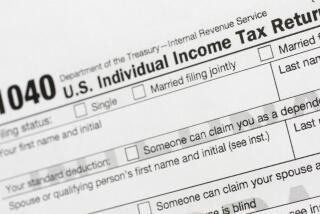From Lincoln to Clinton
- Share via
Paying off the Civil War
* 1862: Abraham Lincoln enacts and emergency measure to pay for Civil War: minimum 3% tax rate.
* 1872: Lincoln income tax law lapses.
* 1894: A 2% federal income tax law is enacted.
* 1895: Income tax is ruled unconstitutional by the U.S. Supreme Court in Pollack vs. Farmers Loan & Trust.
Blame it on Wyoming
* 1909: The 16th Amendment authorizing Congress to collect taxes on income is proposed.
* 1913: Wyoming casts the 37th vote, ratifying the 16th Amendment. One in 271 people pays tax (1% rate).
Tinkering Begins
* 1926: The Revenue Act of 1926 reduces taxes because too much money is being collected.
* 1939: Revenue statutes are codified. One in 32 citizens pays (4% rate).
* 1943: One out of three people pays income taxes. Withholding on salaries and wages is introduced.
* 1954: The 875-page Internal Revenue Code of 1954 passes. It is considered the most monumental overhaul of the federal income tax system to date, with 3,000 rule changes.
* 1969: The Tax Reform Act contains major amendments to the 1954 overhaul.
* 1984: The Reagan Tax Reform Act is most complex bill ever, with more than 180, technical corrections.
* 1986: The Tax Reform Act reduces tax brackets from five to two.
The Latest Fine-Tuning
1993: Bill Clinton’s Revenue Reconciliation Act passes by one vice presidential vote.
1995: A major budget stalemate shuts down the government. Clinton vetoes the Revenue Reconciliation Bill of 1995.
1996: Clinton signs the Taxpayer Bill of Rights 2.
1997: Taxpayer Relief Act brings more than 800 changes: child tax credit, Roth IRAs, capital gains tax rate cuts, breaks for higher education.
Source: CCH Inc.
More to Read
Sign up for Essential California
The most important California stories and recommendations in your inbox every morning.
You may occasionally receive promotional content from the Los Angeles Times.










